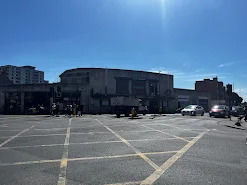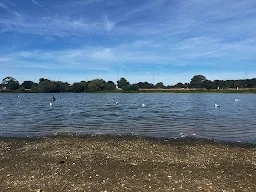The common is a good place to start, it being the leafiest part of Wimbledon and coming in at a large size of about 270 hectares. It's also contiguous with Putney Heath, and is separated from Richmond Park by only the A3. Thus it would be a great place to stroll around on a warm Tuesday morning if you hadn't already decided to visit other areas.
I visited a small section at the southern end of the common, around Rushmere Pond, which you can get up close to, to the point where the muddy shore meets the water. It's a rather tranquil area, with lots of open land in the distance, contrasting perfectly to the main road and its traffic. There were a few joggers around, along with families and sunbathers, but I suspect it's more populated at weekends.
There's also the windmill to the north of the common, which I visited many weeks prior to my trip. It's alliteratively called Wimbledon Windmill was a corn mill, which opened in 1817, though there had been plans to build the windmill since 1799. It continued operating until 1871 after the Marsh family, who operated the mill, were convinced to sell it but ensured parts were dismantled so wouldn't compete with other mills. After becoming accommodation for over a hundred years, it's been converted into a museum which was closed when I visited.
Wimbledon Common is perhaps also notable for inspiring Elisabeth Beresford to write a children's book series about a group of creatures - the Wombles - who clean up the common. Countless books, hit singles, television shows and football mascots later, it's hard to claim the Wombles didn't have an impact at their peak - I even got a Wombles book in primary school, decades after the Wombles truly hit the British psyche.
Though not part of the common, Cannizaro Park is a short walk away and is another lovely place to visit. It's name is derived from the Duke of Cannizzaro, who resided in Sicily but had an estate here, which included the park. Various politicians like Robert Walpole lived in the large house which occupies the western side, though that's now a hotel (and the nearby houses have also been home to people like Spencer Gore, who won the first Wimbledon championship).
The park prides itself on its various tree species, and includes the odd sculpture here and there. There's one of an odd jug by the entrance, and another of the Roman goddess Diana nursing a doe, scattered around various trees leading the way. There's the pond, largely hidden from the rest of the park, as well as various gardens - in the Italian Garden, a woman was softly playing a guitar, which I only noticed after wondering where the music was coming from. From there I made my way back round, through a path that led nowhere except for the neighbouring golf course, and returned to the common proper.
From here it was a brisk walk to the tennis grounds themselves. The Wimbledon Championships have been played since 1877, initially for amateurs though has since become possibly the most prestigious tennis tournament in the world. Maintenance work was going on around the courts when I visited, with cranes and scaffolding surrounding Centre Court, and various workers in purple uniforms walking around the place. There are eighteen grass courts in all, with various other courts dotted around the area, which will likely be overrun with tourists and fans come July next year.
Just by the complex is a golden postbox, honouring Andy Murray's gold medal at the Olympics in 2012, and I found it interesting he's been honoured here and not in his hometown - perhaps it's fortuitous he ended up winning the men's singles here a year later. There's the tennis museum and the large Wimbledon Park, with its central lake, nearby, but I decided to not visit them, perhaps leaving them for a future blogpost, and I made my way to the town centre.
There are two main centres in Wimbledon - the older village, located a fair distance from the area with the theatres, clubs and railways. Wimbledon Village is where the town initially grew, with various wealthy families building houses here owing to its distance from London and the manor itself often owned by the monarchy. However, when the London and South Western Railway opened Wimbledon station in 1838, the focus was diverted away from the village, and the population began to rapidly increase. The District line arrived here in 1889, and in later years it became part of the Sutton loop and tram network.
Whilst the village has the nearby local museum (which was also closed) and has a distinctly quaint charm about it, what with the nearby common, the town centre has two theatres (New Wimbledon and the Polka), various shopping centres, and is far more concrete than grassy. New Wimbledon Theatre, the eighth largest in London and with splendid architecture to boot, is possibly the only one to have had Turkish baths in its basement. Arguably, Wimbledon has sprawled further than that as well - Southfields is a distinct area, though more pass through when the tennis is on; Wimbledon Chase is one stop down the line; South Wimbledon saw an influx of people when the Northern line arrived there.
I walked down to South Wimbledon, and it's distinctly more residential and less chic than Wimbledon. To the south lie trade centres amidst a web of dual carriageway A roads, with the odd park like Nelson Gardens which, with its sculpted cannons, are in honour of Lord Nelson. The more intriguing Morden Hall Park lies further south, though I'd argue Wimbledon definitely ends by that point.
A24 at Balham, Tooting, and Colliers Wood











Comments
Post a Comment